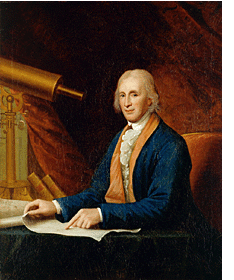
This portrait of Rittenhouse was probably painted just after his death, and served as the basis for an engraving published by Edward Savage. As in earlier portraits of both Rittenhouse and Franklin by Peale, he wears a blue banyan with a pink silk lining, and is seated with his books and papers. The reflecting telescope at his right might be the one that he had recently inherited from Franklin. The diagram on the table depicts the path of a comet, perhaps the one Rittenhouse had discovered in January 1793, and the diagram partially rolled up on the left seems to depict the inner solar system. Rittenhouse was heaped with honors in his last years, including election to the Royal Society of London in 1795. A week after Savage's engraving was published on December 10, 1796, Benjamin Rush eulogized Rittenhouse before the Philosophical Society, drawing parallels between Rittenhouse's career and that of Isaac Newton, including their political activities. Imagining Rittenhouse in his observatory, where he had been buried, Rush concluded, "In entering it—we behold the telescope, dear instrument of his discoveries, turned upon its axis, and pointed to the earth, which has closed its master's eyes." In the Peale portrait, however, Rittenhouse lives on, telescope oriented upwards—the image of an American Newton and patriot.  Title image: Culpeper-type microscope/ Courtesy National Museum of American History, Smithsonian Institution, Washington, D.C. |
 David Rittenhouse 1732–1796
David Rittenhouse 1732–1796